Braun Multimag SlideScan 6000 Test report
In February 2012 the company Braun Phototechnik GmbH from Nuremberg released the nowadays fourth generation of the Multimag Slidescan as follower of the Multimag SlideScan 4000b. Substantially the new Braun Multimag SlideScan 6000 differs from its predecessor in an improved sensor: It provides a nominally resolution of 5000 dpi - the predecessor model only reached a value of 3600 dpi.
In the matter of outer appearance Braun is still uncompromised because like already for the predecessors also this time the design of the scanner wasn't changed and it is still equal to the Paximat Multimag slide projectors, which were already released in 1992. So the new model isn't just a facelift-version of the predecessor, as one used to know from many sectors today, but one can hope for technical innovations.
Equipment, accessoires and performance data of the scanner
The outer appearance of the SlideScan 6000 differs from the predecessor only in the model description. The case was not changed by Braun Phototechnik. This is not inevitably necessary, since the scanner is built robust and designed funcionally, however, an optic difference to the predecessor would create a better overview in the field of magazine scanner.
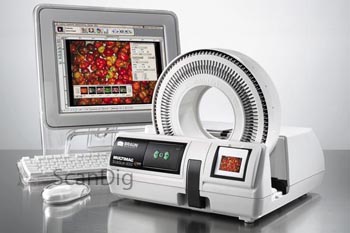
There were no innovations in the equipment. The hardware based dust- and scratch correction ICE is now named Multi-Touch and differs only in the software side from its predecessor's version - the change has just reasons in term of legal license. For the scanning with SilverFast also in the matter of its name everything stays the same.
As usual the scanner is connected to the PC via an USB-2.0-interface. Mechanism, user control elements and optical appearance correspond to a usual slide projector - but the objective is missing. Instead a LED-light source and a CCD-sensor are located in the inner part. And here also the innovation for the Multimag Slidescan 6000 is located: Here one is offered a resolution of 5000 dpi. According to statements of the manufacturer also the maximum density Dmax was increased. The maximum color depth results to 48 Bit like for the predecessor.
The user control elements are neatly arranged and easy to understand: three buttons, which serve for moving the magazine step wise forth and backwards and for launching of the scanning process. The green LED indicates the current status of the scanner. The little emitting field serves for slide watching, say a kind of slide watcher, because the indicator field turns itself automatically on, as soon as a slide will be placed in it.
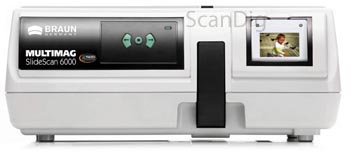
37 x 37 mm is the maximum scanning area. As is generally known the 35mm format size results to 36 x 24 mm. Therefore it is also possible to scan portrait format pictures, without turning them prior to landscape format. The scanner consists of a software based, automatically format recognition, so that the accordingly right picture extract can be fetched.
In the delivery scope of our test scanner there were also included two small CS magazines, which could hold 40 slim slide frames each. This ensures that you can work with the scanner if you have stored your mounted slides in magazines which the Braun SlideScan 6000 does not support. The scanner can process a lot of usual slide magazines: Paximat magazines, Universal magazines, LKM-magazines, CS-magazines and Paximat round magazines. In our online shop you find a big chhoice of slide magazines in different sorts.
If you have stored your mounted slides in archive sheets or in another way outside of magazines you have to resort them into a compatible slide magazine before scanning.
Since it is a pure slide scanner, the Braun Multimag SlideScan 6000 can only process framed 35mm films. In order to process negative film strips they have to be cut and framed. In the scan software you only have to switch between positive film material and negative film material.
Installation and setup the Braun Multimag Slidescan 6000
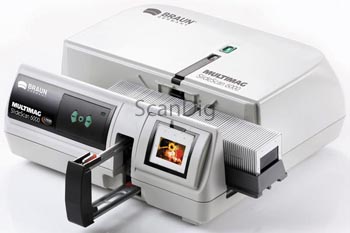
The installation is done like for most other USB-devices: Install the software → supply power to the scanner → connect it via USB 2.0 to the computer and turn it on → scanning. After the turning on the Operating System announces that a "new hardware was found". The installation of the necessary device driver, which was deposited in the OS at the software-installation, occurs automatically. The LED at the scanner stops blinking and lights permanently, as soon as the scanner is operational.
First the slide magazine is pushed into the scanner. Here is no difference compared to a normal slide projector. If the magazine is located in the scanner, all that is left will be controlled via the software or the control elements at the device. To get free function improvements and bug-fixes it is necessary to check regularly if there are software- or driver-updates available. These will be supplied free on the website of Braun Phototechnik.
Since the Braun Multimag Slidescan 6000 is very similar to the Reflecta DigitDia 6000 concerning hardware, you can also use updates of the Reflecta for the Braun, since on the Reflecta homepage you can often find the latest drivers for these scanners.
Before scanning of your complete slide collection one should perform some test scans, hereby one can get used to the mechanism of the scanner and on the other side testing which preferences are most qualified for the own slides. The planed purpose and the personal taste here are very determining. So for the software functions therefore the word is "learning by doing".
Scanning of mounted 35mm slides with different magazine types
The Braun Multimag Slidescan 6000 can process a big number of magazine types. Other film formats like mounted 35mm slides are not supported. Principally the digitalization of 35mm film strips is possible if they are cut into singular pictures, framed and put into a magazine.
According to the manufacturer Braun the following magazine types are supported:
- Reflecta CS magazines for 40 or 100 CS slides
- Universal magazines with DIN 108 for 36 or 50 slides
- Paximat 36/36S, 50/50S und round magazines 100/100S
- Paximat Multimag compact magazine 50
- LKM magazines
If you have stored your mounted slides in other exotic magazines, you have to resort them into a supported magazine type before scanning. The CS magazines from reflecta seem to work best. However, you should be aware, that a complete magazine with 100 slides will not be digitzed always within one scan batch job. Again and again the scanner can get stuck.
In our tests there were in average about 1-2 jams per CS magazine with 100 slides. Such a jam requires a manual interaction in order to continue the scan process. This is not really bad. It is only annoying if you leave your house after starting a batch scan and realize after your return, that the scanner got stuck already after a couple of scans.
Paximat round magazines work enjoyable very well. The reason might be that mounted slides in this type of magazines are hold relatively precisely in their position. However, with occasional jams one has to live with also.
With LKM magazines the SlideScan 6000 works pretty reliably, however with more interrupts than with CS magazines on average. The most difficult barrier for the scanner, however, are universal magazines. This is especially the case if there is a big number of different frames inside, from thick to thin and from glass frames over plastic frames up to cardboard frames. In such a case it might be better to resort the magazines consistently with the singular frame sorts. Otherwise it is recommendable to stay near by the scanner in order to restart the scanner again and again.
If you want to digitze your complete slide collection with the Braun Multimag SlideScan 6000, you should know, that a non-stop scan of a complete magazine is rather seldom. In practice there are again and again jams and interrupts, so that you have to restart the scanner.
For a smooth slide frame transportation you should consider the following: The slide frames have to be in a good state, i.e. not damaged or bent. If you use universal magazines or standard Paximat magazines (i.e. not type S) in combination with thin slides like cardboard frames or CS frames, there is a small orange adaptor for the transportation pusher of the Braun SlideScan 6000. This adaptor must be shifted to front and provides with its wide bearing face a better support for thin frames. This prevents the transportation arm to move over the slide frame.
If you want to make sure while scanning that the right slide will be scanned, the Braun has a built-in slide lift. Via this slide lift also singular frames can be shifted into the scanner and be digitized. Another useful feature is a small slide viewer on the right side of the front side. With this a slide can be checked very quickly and easily before beeing digitzed.
Let's come to the important point of film cleaning. In order to avoid time consuming corrections in the image editing program afterwards, the film material should be cleaned before scanning. This can be done very comfortably in the case of slide magazines by using a Anti Dust Spray, spraying through the singular frames. With this measurement the big dust particles will be removed. Of course, the Braun Multimag SlideScan 6000 also has the MagicTouch function in order to correct dust and scratch automatically, however, a pre-cleaning is recommendable by all means, since the automatic dust and scratch correction fails exactly there, were bigger dust particles cover detailed image information. These bigger particles cannot be spirited away with the automatic functions. And furthermore it is better, if less dust particles get into the scanner, since the sensitive scanning unit is preserved resulting in a longer life-time of the scanner.
Ir you are not satisfied with such a raw cleaning by anti dust spray, we can recommend the use of a anti static brush in order to get optimal image results. With such a brush significantly more dust can be removed that with compressed air.
The scan software of the Braun Multimag SlideScan 6000
Braun Phototechnik includes the scan software Cyberview (tested with version x5). This software offers the basic features in order to digitize slides and control the scanner. With a couple of tools basic image settings can be done before scanning.
For example, with the setting variations the colour and brightness of the images can be set by looking at small previews. With the setting colour matching the brightness, contrast and saturation of an image can be set by shifting three controllers.The tonal values of the gradation curves can be influenced by the tool curves and planes. The setting possibilities, however, are very imprecise using these tools. A selective colour correction, for instance, is missing.
For the control of the batch processing there is a small window called miniature views and 5 buttons. With these the transport of frames can be controlled (forward, back, reload magazine, set actual position and go to...). With the thumbnails one can either look at a certain number of frames or at the complete magazine. The creation of such a thumb nail view of all slide frames in a magazine takes a long time, since the scanner has to work through the complete magazine, even if due to the very low preview resolution less time is needed than for a complete scan.
The CyberView scan software has not changed essentially from version to version. The operation is not really intuitive. Therefore a certain time for learing is needed.
A better alternative, which delivers much better images, is the professional scan software SilverFast Ai Studio. It offers the user much more precise setting possibilities during the scan process with the Braun Multimag SlideScan 6000. In the following chapter about the image quality we will demonstrate the advantages of the SilverFast scan software. You can find detailed information about the SilverFast scan software on our site FAQ SilverFast.
The image quality of the Braun Multimag SlideScan 6000
Let's talk about the image quality, the decisive creterion for the purchase of a scanner. Therefore we measure first the resolution which the scanner achieves in practice, then we analyse the hardware based automatic dutch and scratch removal correction and then finally have a look at the colours, which the scanner yields with different scan software.
Resolution test
Let us start with a resolution test, i.e. which resolution the Braun Multimag SlideScan 6000 acheives in practice. Therefore a USAF-1951 test chart is used. On our page resolution we explain in detail how the resolution test works.
At the beginning of the assessment there are the manufacturer's data: A 35mm scan (36 x 24 mm) with the given maximal resolution of 5000 ppi results calculationally in an image file with 7087 x 4724 Pixels, i.e. in total about 33,5 million pixels. In the uncompressed TIF-format this results in an image file of almoust 96 MB.

The adjacent image shows a detail part of the scan of a USAF 1951 test chart, which was scanned with the nominal resolution of the scanner, i.e. 5000 dpi. At a deep contemplation of the bars one realizes that one can recognize the element 2 of the group 6 at the horizontal resolution (which corresponds to 3649 dpi according to the resolution table) and that one can recognize the element 3 of the group 6 at the vertical resolution (which corresponds to 4096 dpientspricht gemäß der Auflösungstabelle 3649 dpi) und bei der vertikalen Auflösung noch das Element 6 der Gruppe 3 (which corresponds to 4096 dpi). The average of these two values gives a resolution of 3900 dpi for the tested scanner. This corresponds to 78% of the resolution given by the manufacturer (5000 dpi). This is a very good value, since lots of scanners don't achieve more than 50% of the nominal resolution in practice.
A 35mm scan with an effective resolution of 3900 contains about 20 million pixels, that's enough in order to take out all image information from a 35mm film in terms of resolution. Since there are 33 million pixels when scanning with 5000 dpi means that 13 million pixels are double. After scanning it is recommended to reduce these 33 million pixels to 20 millions. That means some time, however makes the resulting imag efiles smaller and better manageable.
The Braun Multimag SlideScan 6000 provides an effective resolution of 3900 dpi at a 5000 dpi scan and so yields image files with effectively about 20 million pixels.
Let's compare the measured value with other magazine scanners: The Reflecta DigitDia 6000 scans nominally also with 5000 dpi, achieves effectively, however, only 3300 dpi, which corresponds to about 14 million pixels. So the Braun Multimag SlideScan delivers a about 600 dpi higher resolution than the DigitDia 6000 at the same nominal resolution, so that in the image files there are effectively about 20 million pixels instead of 14 millions. Let's compare the resolution of the Braun Multimag SlideScan 6000 with the much more expensive Nikon Super Coolscan 5000ED. We recognize that both achieve the same effective resolution of 3900 dpi at different nominal resolutions. The Nikon scans with 4000 dpi and provides 3900 dpi effectively, whilst the Braun Multimag SlideScan 6000 scans with 5000 dpi and provides 3900 dpi effectively. The fact that the Nikon achieves 97% of its nominal resolution in practice and so a subsequent data compression is not necessary any more, demonstrates the extremely high quality of the Nikon LS-5000 ED.
Automatic dust and scratch removal
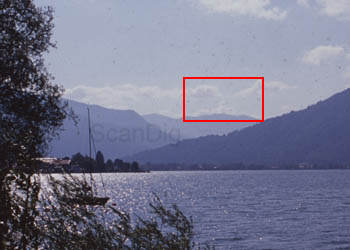
An important criterion for the assessment of a film scanner is the automatic dust and scratch removal function, which nowadays is standard at good scanners. We will have a look at it in the following. Therefore we have scanned the very dirty slide both with the Braun Multimag Slidescan 6000 and with the Nikon LS-5000 with automatic dust and scratch removal. In order to demonstrate the difference better, we show the red marked area in the following picture, which you can enlarge with a mouse click, in detail. If you click at the detail picture the view changes between the two scans and the scan without scratch and dust removal. In order to show clearly where there are some remaining dust particles, we have also added a picture with these area red marked.

In the detail picture you can see very clearly, that the MagicTouch/iSRD function of the Braun Multimag Slidescan 6000 does a very good job, however, the scratch and dust removal function ICE of the Nikon Super CoolScan 5000 ED works a bit better. Especially in homogenous colour areas like the sky you can see some remainings of the dust and scratches at the Braun scan. Nevertheless one can state that the hardware based automatic scratch and dust removal function works very well at the Braun Multimag SlideScan 6000 and so improves the image quality essentially. Like at all film scanners the automatic scratch and dust correction is based on an additional infrared scan of the film. For black & white films, however, this technique is not applicable unfortunately.
The hardware based automatic dust and scratch removal works very well at the Braun Multimag SlideScan 6000 and leads to a significant increase of the image quality (at colour films).
Image quality using the SilverFast Ai Studio scan software
Also the software is decisive for the quality of the scans. As written in the chapter software, the Braun Multimag Slidescan 6000 is available both with the manufacturer's software CyberView and with the professional SilverFast Ai Studio software. A special feature of the silverFast scan software is the IT8 calibration (see our page scanner calibration). With that feature the colour errors of the scanner are measured with the help of a standardized target and stored as correction data in a scanner profile. We have made scans for comparison both with and without IT-8 calibration in order to demonstrate the quality increase.

If you click on the adjacent image the view changes between the three scans. First you see the slide scanned with CyberView. It is noticeable that the image is very low-contrast and flat. The green tones are not so depp as they should be. That is different at the scan with SilverFast Ai Studio. Here the colours are significantly fresher and more dynamic. This shows that you get a significant increase in the image quality just by using a professional scan software. The colours become even better if you calibrate the scanner with an IT8 target. Here the green tones are much brighter and there is more drawing in the dark areas. How the IT-8 colour calibration works in detail and which target you should choose is explained on our FaQ-site about SilverFast.

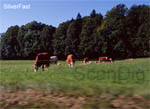
In the following we show two more examples which demonstrate which quality increase can be achieved using SilverFast Ai Studio and IT-8 calibration instead of the standard scan software CyberView. For comparison the view changes between the two scans with CyberView and SilverFast Ai Studio. Again you can see clearly that the images, scanned with SilverFast, are significantly more dynamical. On the first image the leaves of the tree glow really red if you look at the scan made with SilverFast. On the CyberView scan, however, it is only a pale red. Also at the blue sky you can see the difference clearly. On the second image you can see well, that the grass, the cows and the sky have significantly more natural, strong colours.
SilverFast Ai Studio leads in combination with the IT-8 colour calibration to a significant increase of the image quality at the Braun Multimag SlideScan 6000.
Whilst you have to postprocess scans, which are made with the simple scan software CyberView, almost always in the image editing program, the results of an IT-8 calibrated scanner are often so good, that you can do without the time consuming rework in the image editing program.
The scanning speed of the Braun Multimag SlideScan 6000
The Braun Multimag SlideScan 6000 is designed to process large amounts of slides in batch mode. That's why the scanner don't has to glisten necessarily with a high scanning speed. During a batch scan the scanner usually is let alone, and after a while one looks if everything goes alright.
Anyway it is important to know if a magazine takes one hour or ten hours in order to be scanned completely. That's why we have made a speed test and measured the scanning times. For our tests the scanner was connected to a Windows PC with 64 bit operating system, Core i7 processor and 8 GB RAM. The scannner was operated with the firmware version 1.12.
The following scanning times are measured with SilverFast Ai Studio version 8.0.1r22:
| Action with SilverFast Ai Studio |
without iSRD |
with iSRD |
| Prescan of a slide |
0:23 min |
- |
| Scan of a slide with 1250 ppi |
0:44 min |
1:22 min |
| Scan of a slide with 2500 ppi |
1:30 min |
1:55 min |
| Scan of a slide with 5000 ppi |
3:30 min |
8:17 min |
| Scan of a magazine (100 slides) 5000 ppi |
- |
approx. 14 h |
In the following table there are the scanning times measured with the manufacturer's software CyberView X5 version 5.14.20:
| Action with CyberView X |
without MagicTouch |
with MagicTouch |
| Prescan of a slide |
0:50 min |
- |
| Scan of a slide with 1250 ppi |
0:44 min |
1:22 min |
| Scan of a slide with 2500 ppi |
1:33 min |
1:54 min |
| Scan of a slide with 5000 ppi |
2:58 min |
4:08 min |
| Scan of a magazine (100 slides) 5000 ppi |
n.a. |
approx. 7 h |
In both tables you can see in the first column the scanning times without and in the second column the scanning times with automatic dust and scratch removal. Since you usually use the automatic dust and scratch correction always in practice (execpt for black/white photos, for which it does not work), the scanning times in the right column are relevant for practice. Normally you scan your mounted slides with a nominal resolution of 5000 dpi in order to get the best possible results. When operation the scanner with SilverFast Ai Studio there is a scanning time of a bit more than 8 minutes, when oprating with CyberView a scan takes a bit more than 4 minutes.
The time difference between SilverFast Ai Studio and Cyberview is about 100%. That means that a scan with SilverFast Ai Studio takes about the double amount of time compared to CyberView. The explanation is obvious: SilverFast makes with the raw data, which are provided by the scanner, much more complex calculations in order to achieve a significantly better image quality. The real scan, i.e. the time where the scannner works, also is oever after 3:30 minutes within SilverFast; the remaining 5 minutes are taken completely by the image processing algorithms of the SilverFast scan software. If you compare the image results of SilverFast with them of CyberView, you will at least understand, why you had to wait such a long time.
If you scan a magazine with 100 mounted slides with 5000 dpi and switched on dust and scratch removal correction, you have to schedule about 14 hours for that procedure (if the scanner does not get stuck). If you have a typical slide collection of 10.000 mounted slides you have to schedule at least 100 days for that job. While a private person does not have problems with that time, in commercial fields one gets quickly to the limit of effectivity with that scanning speed. If you consider that the goold old Nikon Super Coolscan 5000ED is able to digitze 100 mounted slides in about 2 hours in excellent quality, the 14 hours, which are needed by the Braun Multimag SlideScan 6000, are a pretty long time.
Warranty
Braun Phototechnik limits the warranty for the Multimag SlideScan 6000 to a number of 20000 scan processes. A scan process can be an index scan, a prescan or a main scan. If you choose the option multi-exposure within the scan-software, the film will be scanned twice and the scan counter increases by 2. The same holds for multi times scans.
Conclusion, result
The Braun Multimag SlideScan 6000 is a magazine scanner, which was built for scanning large amounts of framed 35mm slides. Concerning scanning speed it is not a fast sprinter, but the fact, that it can process a complete slide magazin in batch mode, makes the scanning speed rather unimportant.
Under a large amount of slide mounts the manufacturer Braun Phototechnik denotes it with 20.000. The warranty of the manufacturer is therefore limited to 20.000 scans. Braun writes explicitly in its warranty instructions that the DigitDia 6000 has been developed only for private use and not for commercial applications.
While the image quality is rather average using the standard scan software CyberView, the Braun Multimag Slidescan 6000 yields very good scans if you operate it with SilverFast Ai Studio and do an IT-8 colour calibration before scanning.
With a very high effective resolution of 3900 dpi it beats significantly its direct competitor Reflecta DigitDia 6000 and can even match with the much more expensive Nikon Super Coolscan 5000 ED. In terms of image quality and scanning speed, however, it is miles away from the top results of the much more expensive Nikon 5000.
All in all we can conclude that the Braun Multimag Slidescan 6000 with SilverFast Ai Studio is the top recommendation for scanning mounted slides in batch mode at the moment.
Back to the film scanner tests index
|